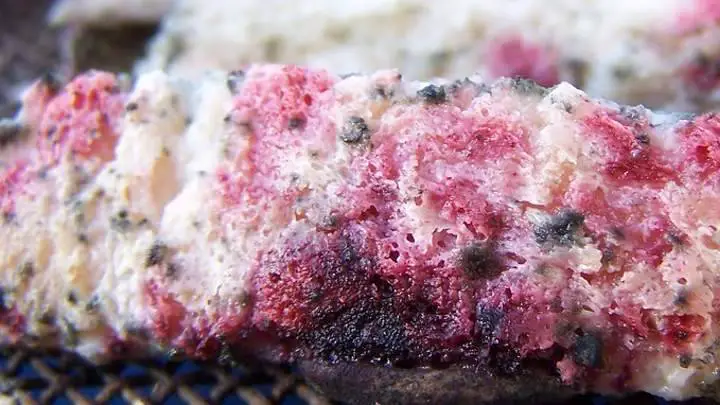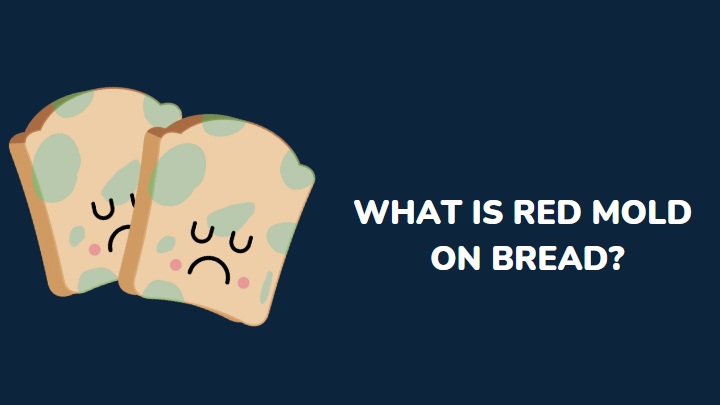Have you ever seen red mold on bread? It looks awful. Red mold is a type of fungus that grows on bread and other foods and surfaces like walls and ceilings.
As a baker, I get a lot of questions about why red mold appears on bread. And after researching this subject, I decided to write an article about it.
Keep reading to know what red mold is, why it grows on bread, and how to prevent it from growing on your bread.
What is red mold?
Red mold is a common term used to refer to types of mold that produce reddish-brown spores.
This mold is present in every country in the world but is most commonly found in humid, warm climates.
Red mold appears on almost any food item, no matter how clean it is. But it appears more in foods like meat, fish, sandwiches, and bread. It thrives in damp, warm environments with high humidity levels, like kitchens and bathrooms.
Red mold on bread
Red mold on bread is commonplace. It is the result of exposing your bread to environmental conditions that favor the growth of mold spores.
Red mold usually appears on the surface of the bread, but it can also appear inside the bread.
In addition to being an eyesore, this type of mold can cause allergic reactions in some people if they eat bread that has been contaminated by it. If you notice red mold on your bread, trash the entire loaf.
What causes red mold on bread?
There are several causes of red mold on bread. The most common cause is excess moisture in the bread.
When you keep your bread in a warm, humid environment, such as your kitchen or near an open window, it quickly becomes moldy and starts to rot.
This rot happens because moisture enters the bread through its surface and increases the moisture content inside the bread. Once this happens, red mold and other harmful microorganisms begin to grow on the bread’s surface or inside it.
Can red mold kill you?
No, it can’t.
However, you should tread carefully because red mold is a common allergen. If you’re allergic to red mold, you may experience symptoms such as sneezing and a runny nose upon contact.
If you experience severe symptoms after coming in contact with red mold, contact your doctor immediately. You can also call 911 or emergency response if you think you’re having a severe allergic reaction.

What to do if you find red mold on your bread
- Discard the bread immediately.
- Throw away any food items that may have come in contact with the bread.
- Wash your hands before touching anything else in the kitchen.
- Wash all surfaces that have come in contact with the mold to remove all traces.
- Don’t use bleach or other harsh chemicals to clean up the moldy area; they could cause more harm than good.
- See a doctor if you experience any allergic reaction.
How can you prevent red mold growth on bread?
Store your bread properly
The first step in preventing red mold growth on your bread is to store it properly. Red mold thrives in environments with high moisture, so be sure to keep your bread away from places like that.
Keep your fridge clean
Try as much as possible to always keep your refrigerator clean. If there are spills in your fridge, clean them up immediately because they are likely breeding grounds for mold spores.
If you notice any odors coming from your fridge, check and remove the items responsible for the foul smell. Otherwise, it will attract mold spores to your bread and other food items in the fridge.
Wash your utensils and plates before using them
Wash your utensils and plates with soapy water and rinse thoroughly. Make sure that all the water drains out before cleaning them with a clean cloth.
This will help remove any mold spores as well as bacteria and other microorganisms that may be present on their surfaces.
Make sure you don’t have any leaks in your house
You should also make sure that water is not dripping from any leaks in your roof or windowsill.
Leaks can cause water to pool up around your house. When this happens, mold spores breed and travel through the air contaminating your bread.
FAQs
Does red mold cause air pollution?
Yes, it does. Red mold is one of the most common types of indoor air pollutants. It mostly occurs in kitchens, bathrooms, and other areas where there is moisture.
If you have red mold in your bathroom, kitchen, or other areas in your house, then you need to clean them immediately. If you can’t get rid of the red mold, contact a professional mold removal company right away.
What happens if you eat moldy bread?
If you eat moldy bread, the mold will enter your bloodstream and produce toxins that can make you sick.
The degree of harm these toxins cause depends on how much moldy bread you ate and your initial health condition.
Can red mold grow on cheese?
Yes, it can. Red mold commonly grows on blue cheeses like Danish blue, Stilton, Gorgonzola, and Bleu d’Auvergne. It can also grow on other types of cheese, such as Parmesan, Cheddar, and Brie.
To prevent any type of mold from growing on your cheese, always store your cheese in an airtight container and keep it away from moisture.
If your cheese looks fine, but the surface swells up and turns red when you cut into it, discard it immediately. This is an indication that red mold spores have started to grow in it.
Can red mold grow on rice?
The answer is yes. Red mold on rice is a common occurrence that happens when the spores in the air contaminate your rice and cause mold to start to grow in it.
If you notice red mold on your rice, discard it immediately and wash your hands with soap and water.
Conclusion
Red mold on bread is a common contamination that usually occurs as a result of excessive moisture in the bread and improper storage.
If you notice red mold on your bread, it’s time to throw it out and make some changes in your storage methods.
Also, if the bread looks funny but you’re not sure whether it’s been contaminated with mold, throw it out and wash any contaminated foods and surfaces immediately. Do not risk ingesting red mold.
I hope this article was helpful. Remember that your bread is not the only food exposed to mold growth. Your chocolates are too. Read about the signs and prevention of mold on chocolate.
Thanks for reading.
